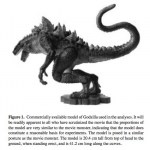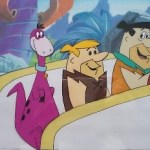dinosaurs
A very large Azhdarchid shown with a human for scale. Azhdarchids were pterosaurs (flying reptile-like creatures) of the Cretaceous. These included some gigantic critters with up to a 10 meter wing span, but also some little ones (2.5 meters or so). Most reconstructions of these flying animals have them skim-feeding across the surface of bodies of water, grabbing near-surface animals with their beaks.
A new paper in PLoS criticizes this view suggesting that there is very little evidence in support of it, and offers an interesting alternative interpretation of Azhdarchid morphology.…
Sometimes, you find weird stuff on the internet. But sometimes you find even weirder stuff in scientific journals. To what do I refer? A paper in the Journal of Mathematical Geology back in 2000 entitled Godzilla from a Zoological Perspective, by Per Christiansen.
This was written as a critique of the "new Godzilla" movie, arguing that it is not more biologically plausible than the "old Godzilla" of 1954.
However, calculations show that his limbs and limb muscles must have been severely undersized to move his huge bulk around at even a leisurely pace, and most other biological problems with…
The American Association of Physics Teachers just published a study of 1,000 likely U.S. voters about science, religion, evolution, and creationism. The results are frightening. Here are some of the "highlights" of their study:
38% of Americans are in favor of the teaching of religion in public school science classrooms.
65% of Americans do not think that it is an important science goal to understand the origin and diversity of biological life on Earth.
47% of Americans believe that the earliest humans lived at the same time as the dinosaurs.
21% of Americans do not believe that the…
Some of my colleagues are downplaying the recent paper in science showing a: that mastodons are elephants and b: that birds and dinosaurs ... in particular Tyrannosaurus rex and turkeys ... are related. (See here and here, for instance)
Yes, it is true that these phylogenetic findings are wholly uninteresting, being exactly what we expected. But that is WHY these particular phylogenies were carried out.
You see, the research is being done with organic material that is very very old, and is amazingly, remarkably, unexpectedly and astoundingly preserved. The point of using this material to…
tags: What Bugged the Dinosaurs?, dinosaurs, insects, disease, George Poinar, Roberta Poinar, book review
I grew up with a fondness for dinosaurs. Their unbelievable size, their peculiar shapes, and their undeniable absence from the world as I knew it were all sources of fascination. But never once did I think of the dinosaurs as being plagued by biting insects and other blood-sucking arthropods; mosquitoes, flies, ticks and mites were creatures that haunted camping trips, picnics and attics, not the majestic dinosaurs! But according to the new book, What Bugged the Dinosaurs? Insects,…
Grrrrrrrrrrrrr....
Welcome to the Lucky 13th Edition of The Boneyard ... the Web Carnival about Bones and Stuff.
"The Boneyard is a blog carnival covering all things paleo, from dinosaurs to pollen to hominids and everywhere in between. It's held every two weeks (the 1st and 3rd Saturday of the month), traveling around to a different blog for each installment, connecting some of the best blogging on ancient life."
The previous edition of The Boneyard is here, at Dragon's Tales. The next edition of The Boneyard will be Here at Archaeozoology. If you would like to submit an entry to the next…
tags: Evolution: What The Fossils Say And Why it Matters, fossils, dinosaurs, creationism, Donald Prothero, book review
I was in love with dinosaurs when I was a kid, and I still am. It was my love for dinosaurs and fossils and especially my time spent learning the minutea of the evolutionary history of horses that quickly brought me into direct conflict with the church that I was being inculcated into when I was very young and innocent. Subsequently, I had to learn about evolution in small niblets on the sly. But I wish I had been able to read paleontologist Don Prothero's beautifully…
tags: researchblogging.org, evolution, bird-dinosaur split, dinosaurs, birds, rocks-versus-clocks, fossil record, molecular clocks
The first feathered dinosaur fossil found in China -- Sinosauropteryx.
The feathers can be seen in the dark line running along the specimen's back.
Image: Mick Ellison, AMNH [larger view]
There is a lot of controversy among scientists regarding when modern birds first appeared. The current fossil record suggests that modern birds appeared approximately 60-65 million years ago when the other lineages of dinosaurs (along with at least half of all terrestrial…
From Dinosaurs and the Bible:
If you're living in or is near the Ontario area, go pay a visit to the Royal Ontario Museum to get a load of the unveiling of a huge dinosaur mount that was previously hidden in the museum storage and forgotten for 40 years until it was rediscovered last year by Dr. David Evans, one of the curators of the museum. A large Barosaurus skeleton nicknamed "Gordo" is going to be on display at the museum as part of the museum's renovated galleries of dinosaurs.
[source]
Go to Dinos and the Bible to get directions to the museum.
With all the recent news about dinosaurs, I thought you'd like to see a video of actual dinosaurs:
tags: dinosaurs, movie magic, streaming video
This interesting time-lapse streaming video shows how the movie industry built some amazingly realistic life-sized dinosaurs [shockwave: 3:50]
tags: feathers, dinosaurs, humor, cartoon
En el tÃpico rito funerario del Jurásico tardÃo unos dinosaurios terópodos depositan plumas sobre el cuerpo de un compañero justo antes de la momificación. Desfortunadamente no pensaron en los paleontólogos del futuro.
Image: The Scientific Cartoonist [larger view].
I am sure that one of my readers, Jerry Harris, will especially like this cartoon.
Thanks Chris!
tags: researchblogging.org, social behavior, evolution, Psittacosaurus, ornithischian dinosaur
Triceratops.
Image: Dinosaur Collector
Triceratops are among the most recognizable dinosaurs because of their distinct appearance. They had a large and elaborate bony shield around the back of their head, horns that jut out from the top of their head and nose like spears, and bony knobs on their cheeks. Because these large structures are energetically expensive to grow, they had to serve a purpose and this purpose was likely the establishment of social hierarchies. Thus, these ornaments provide…
tags: researchblogging.org, archaeopteryx, dinosaurs, mammals, fossils
Archaeopteryx fossil showing the distinctive head-back death pose of many articulated fossilized birds, dinosaurs and early mammals. Archaeopteryx is an ancient feathered dinosaur. This specimen is at the Humboldt Museum, Berlin. The skull is approximately two inches long.
If you've looked at the articulated 150-million-year-old Archaeopteryx fossils, you probably have noticed that they all have a weirdly similar pose; their heads are thrown over their backs, mouths open and tail curved upwards. Scientists have been…
tags: researchblogging.org, Tyrannosaurus rex, dinosaurs, birds, fossils
Repeated analysis of proteins from a fossilized Tyrannosaurus rex reveal new evidence of a link between dinosaurs and birds: Of the seven reconstructed protein sequences, three were closely related to chickens.
Image: NYTimes
It was once thought impossible to obtain actual soft tissue, such as proteins, from fossils, but the impossible has happened and now, two research teams who published reports in this week's Science describe their findings: the closest relative to the fearsome Tyrannosaurus rex is .. a chicken.…

